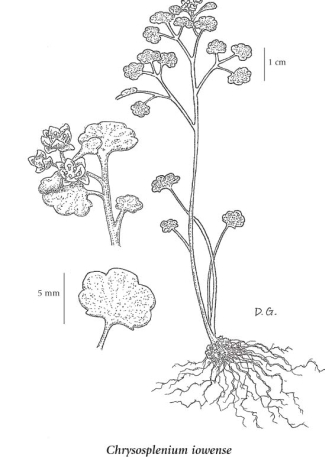Chrysosplenium iowense Rydb.
Iowa golden-saxifrage (Iowa golden carpet)
Saxifragaceae (Saxifrage family)
Introduction to Vascular Plants
Iowa golden-saxifrage (Iowa golden carpet)
Saxifragaceae (Saxifrage family)
Introduction to Vascular Plants
Species Information
General:
Perennial herb from slender rhizomes; stems succulent, erect, 3-15 cm tall, generally branched above, trailing shoots (stolons) leafy.
Leaves:
Basal leaves round-to kidney-shaped, 5-20 mm wide, round-toothed, noticeably veined above (in live plants), often coarse white-hairy, the stalks 1-3.5 cm long, mostly smooth, sometimes red soft-hairy; stem leaves usually 2, sometimes 1 or 3, kidney to fan-shaped, shallowly lobed, smooth.
Flowers:
Inflorescence terminal, of clusters of 5 to 12 flowers, the flowers short bell-shaped, 2.5-5 mm across, the inner flowers larger than outer; bracts yellow, fan- to egg-shaped, lobed; petals lacking; calyces joined to lower half of ovaries; sepals 4, spreading, golden-yellow, 3-veined, the outer pair usually slightly wider than long, the tips rounded or blunt and often curved back, the inner pair similar but narrower so usually longer than wide; stamens 2 to 8, usually 5 to 8 in inner flowers, 2 to 4 in outer; styles 0.3-0.4 mm long, the disk narrow and entire.
Fruits:
Capsules, the free portion 2-lobed; seeds smooth, 0.7-0.9 mm long, light brown.
Notes:
Included by some authors in the European C. alternifolium L., but it is quite distinct (Packer 1991).
Illustration

If more than one illustration is available for a species (e.g., separate illustrations were provided for two subspecies) then links to the separate images will be provided below. Note that individual subspecies or varietal illustrations are not always available.
Illustration Source: The Illustrated Flora of British Columbia